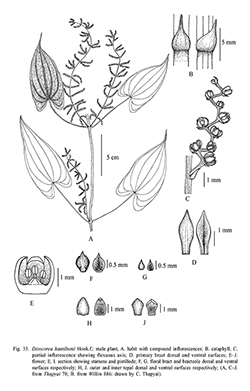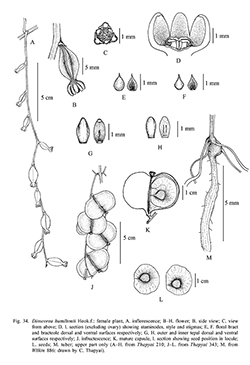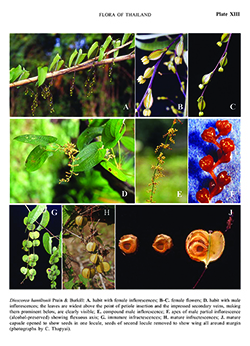e-Flora of Thailand
Volume 10 > Part 1 > Year 2009 > Page 63 > Dioscoreaceae > Dioscorea
18. Dioscorea hamiltonii Hook.f.wfo-0000390828
Fl. Brit. Ind. 6: 295. 1892; Prain & Burkill, J. & Proc. Asiat. Soc. Bengal 10: 39. 1914; R.Knuth in Pflanzenr. 4, 43: 266. 1924; Prain & Burkill, Bull. Misc. Inform. Kew 1927: 239. 1927; in Fl. Indo-Chine 6: 733. 1934; Ann. Roy. Bot. Gard. (Calcutta) 14(2): 299. 1938; Hô, Câyco Viêtnam 3, 2: 927. 1993; Noltie in Fl. Bhutan 3(1): 15. 1994. Fig. 33, 34; Plate XIII.
Accepted Name : This is currently accepted.
Synonyms & Citations :
Description : Climber to at least 10 m. Tubers one per growing season, often with withering tuber of previous season, ca 0.4–1 by 7.5–12 cm, cylindric to clavate, vertically oriented, subtended by a woody crown. Indumentum sometimes present on young inflorescences, axes, stems and the veins of the leaf blade lower surface, hairs simple, 0.05–0.1 mm long. Stems 2–5 mm in diam., twining to the right, annual, unarmed, terete with shallow longitudinal ridges, usually drying a coppery colour in herbarium specimens. Leaves simple, opposite, sometimes subopposite or alternate toward base, blades narrowly to broadly ovate, in stem leaves always broadest above the point of petiole insertion, chartaceous to subcoriaceous, 7–9-veined, secondary venation prominent below, margins entire, base cordate, apex acuminate; petioles 2–8.5 cm long; cataphylls 2–2.5 by 2.5–3 mm, ovate to broadly ovate; bulbils and lateral nodal organs absent. Inflorescences pendent, axes copper-coloured like stem, tepals free, inserted on a discoid torus, fleshy in texture, with inner whorl tepals usually thicker than outer; male inflorescences spicate, simple or compound, compound inflorescences 1–2 per axil, simple/partial inflorescences 1–3(–4) per axil, peduncles 1.2–2.5 mm long, axes 0.8–2.7 cm long, flexuous; female inflorescences racemose, simple, 1–2 per axil. Male flowers with outer tepals 1.2–1.5 by 0.5–1 mm, ovate, inner tepals 1–1.2 by 0.7–0.9 mm, obovate, stamens 6. Female flowers on 1.1–2.5 mm long pedicels, and tepals 2.6–4.1 mm long (at least 2 times larger than males!), otherwise as in Fig. 34B–H. Capsules as in Fig. 34J, K, Pl. 13G–J, 19–25 by 38–43 mm. Seeds 6.5–7.5 by 7–7.5 mm, ovoid-lenticular, wings 19–21 by 17–19 mm, extending all around seed margin.
Thailand : NORTHERN: Chiang Mai (Doi Suthep-Pui, Mae Sa, Mae Ai), Chiang Rai (Huai Nong Pi), Lamphun (Mae Ta), Nan (Doi Phu Kha), Uttaradit (Ban Khok); NORTH-EASTERN: Loei (Dan Sai); EASTERN: Chaiyaphum (Phu Khiao); SOUTH-WESTERN: Kanchanaburi (Huai Bankau, Mae Klong, Sai Yok; SOUTH-EASTERN: Chachoengsao (Ang Rue Nai), Chanthaburi (Khao Soi Dao); PENINSULAR: Chumphon (Sawi), Ranong (Kapoe, Nam Tok Khao Phra Narai), Surat Thani (Ban Ta Khun).
Distribution : N India (lectotype), S China and Taiwan to southern Burma.
Ecology : Open areas in mixed deciduous forests with or without bamboo on limestone and other substrates, 400–1,250 m alt. Flowering: July–November; fruiting: November March.
Vernacular : Man rak (มันรัก)(Chiang Mai); man nok (มันนก)(Kanchanaburi).
Uses: Tuber edible when boiled. According to Prain & Burkill (1936) it is among the most favoured edible yams in, for example, Vietnam and north-east India.
Conservation Status: IUCN red list category LC (IUCN 2001).
Notes: Dioscorea persimilis was treated as a separate species by Prain & Burkill (1938). They suggested that it differed in the more prominent secondary venation on the leaf blade and smaller capsules, and that it was found in Southern China, Vietnam and Laos, while D. hamiltonii was native to India, Burma and Thailand. Ding & Gilbert (2000) retained the name D. persimilis for the Flora of China treatment. However, the authors believe that its variation is continuous with that of D. hamiltonii Ding & Gilbert also supported the separation of D. persimilis into glabrous and pubescent varieties but variation in indumentum density also appeared to the authors to be continuous.



